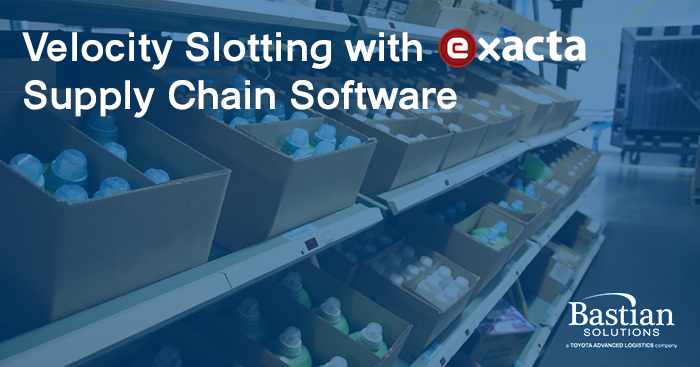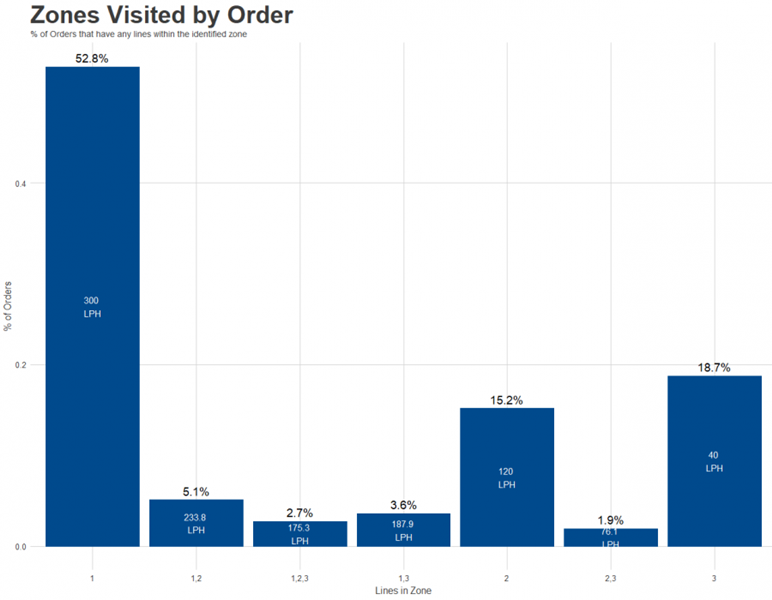
Velocity Slotting with Supply Chain Software
Chris Bratten | 29 January 2019
A little organization goes a long way...
Velocity slotting is a term that’s often thrown around in our industry. When used correctly, velocity slotting can lead to significant gains in operator productivity, dramatically reduce order dwell time and balance workload across several operators. When poorly designed, velocity slotting creates confusing order paths and can result in double or triple handling of orders in the picking process.
Put simply, velocity slotting is an organizational strategy that utilizes storage zones within a warehouse to store products by pick frequency. Faster moving items are stored with faster moving items and slower moving items are stored with slower moving items. Simple, right? Surprisingly, it gets a little more complicated due to the many decisions involved. How many items should be stored in each zone? Should the same picking technology be used in each zone? How do orders move between zones? Where do orders start? All of these questions have to be addressed when designing a system to take advantage of product order frequency.
The first step to determine if velocity slotting is right for your business is to take a look at your SKU profile. A SKU profile is a pareto chart that shows every product by its relative order frequency. If you’re like most organizations, you’ll see a steep incline from the fastest moving products that starts to level off as it gets to slower moving products. Take a look at the SKU profile below:  As you can see, the fastest moving items account for a disproportionate amount of the order lines. The old 80/20 rule is a good rule of thumb when looking at product velocities. That is, if 20% of your products account for 80% of your order lines, velocity slotting could be a big boost to your operations. Once we’ve determined velocity slotting is a good option, the detailed design decisions begin.
As you can see, the fastest moving items account for a disproportionate amount of the order lines. The old 80/20 rule is a good rule of thumb when looking at product velocities. That is, if 20% of your products account for 80% of your order lines, velocity slotting could be a big boost to your operations. Once we’ve determined velocity slotting is a good option, the detailed design decisions begin.
How many velocity zones?
The simplest way to velocity slot is to create two velocity categories using the 80/20 rule. The top 20% of SKUs are labeled as “A” movers and are slotted to a forward pick location in an "A" mover zone. The bottom 80% of SKUs are “B” movers and are stored and picked in a different zone.  Simply storing products together within velocity categories will result in productivity gains. Operators don’t have to walk as much between picks in the high velocity zone due to an increase in pick density. Operators can pick 20%-50% faster in the high velocity zone due to decreased walk time. However, warehouses leave a lot of productivity on the table if they simply stop here.
Simply storing products together within velocity categories will result in productivity gains. Operators don’t have to walk as much between picks in the high velocity zone due to an increase in pick density. Operators can pick 20%-50% faster in the high velocity zone due to decreased walk time. However, warehouses leave a lot of productivity on the table if they simply stop here.
Should the same picking technology be used in each zone?
The real gains in productivity come from utilizing different picking strategies for the pick zones. A tried and true solution is to move the fastest moving SKUs into a pick module utilizing a combination of pallet flow lanes, carton flow rack and bin shelving. Routing cartons to the correct zones eliminates expensive walk time through aisles of racking.
Velocity slotting allows us to give our customers a bigger bang for their buck when using more expensive picking technologies. By assigning products to velocity zones and evaluating historical orders, we can build a probabilistic model to predict the blended picking rate of the system for orders that visit any combination of zones.
Real Velocity Slotting Results
A customer came to us for help increasing their picking efficiency. They currently batch pick orders to a cart with little to no velocity slotting. Their best operators pick at ~75 lines per hour. Our design concept dramatically increased picking efficiency by utilizing velocity slotting in their pick module. A 160-foot, two-level pick module was designed to hold the top 20% of SKUs, or 2,360 product facings. The first level of the pick module utilized Exacta Pick to Light for 960 products. The 2nd level was designed to use Exacta Mobile batch picking from flow rack and bin shelving for the remaining 1,400 products. The low velocity product remained in the existing aisle-based racking.  With this velocity slotting solution, more than 50% of orders will be completed entirely within the first level of the pick module using pick to light with a very fast pick rate. The pick rate of these orders is 4 times faster than the existing operation. In fact, this system is now able to pick orders at more than 200 lines per hour per person across the entire warehouse. Using velocity-based slotting and a high velocity pick to light, this system was able to increase throughput capacity by 177%.
With this velocity slotting solution, more than 50% of orders will be completed entirely within the first level of the pick module using pick to light with a very fast pick rate. The pick rate of these orders is 4 times faster than the existing operation. In fact, this system is now able to pick orders at more than 200 lines per hour per person across the entire warehouse. Using velocity-based slotting and a high velocity pick to light, this system was able to increase throughput capacity by 177%.
Velocity slotting can drastically improve order pick time and operator productivity when used correctly. With careful analysis, Bastian Solutions can help determine if velocity slotting is a good fit for your organization. Contact us to learn more.
Chris is a Logistics Consulting Manager at Bastian Solutions, based in Louisville, Kentucky. He has a Bachelor of Science in Mechanical Engineering from Rose-Hulman Institute of Technology and a MSME from Purdue University. Since starting with Bastian, Chris has developed and maintained strong relationships with his clients; designing solutions and supporting system integrations.
Comments
Manoj Ramteke says:
4/26/2021 07:22 AM
Perfectly written.How are you calculating the slotting velocity of an item?
Is it Picking velocity= (no of times an item is picked from a location)/(defined period)
Natalie Hogan says:
4/23/2020 03:15 PM
Leave a Reply
Your email address will not be published.
Comment
Thank you for your comment.